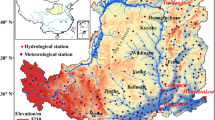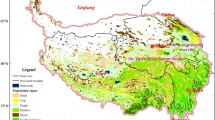Abstract
Spatiotemporal variations of Chinese Loess Plateau vegetation cover during 1981–2006 have been investigated using GIMMS and SPOT VGT NDVI data and the cause of vegetation cover changes has been analyzed, considering the climate changes and human activities. Vegetation cover changes on the Loess Plateau have experienced four stages as follows: (1) vegetation cover showed a continued increasing phase during 1981–1989; (2) vegetation cover changes came into a relative steady phase with small fluctuations during 1990–1998; (3) vegetation cover declined rapidly during 1999–2001; and (4) vegetation cover increased rapidly during 2002–2006. The vegetation cover changes of the Loess Plateau show a notable spatial difference. The vegetation cover has obviously increased in the Inner Mongolia and Ningxia plain along the Yellow River and the ecological rehabilitated region of Ordos Plateau, however the vegetation cover evidently decreased in the hilly and gully areas of Loess Plateau, Liupan Mountains region and the northern hillside of Qinling Mountains. The response of NDVI to climate changes varied with different vegetation types. NDVI of sandy land vegetation, grassland and cultivated land show a significant increasing trend, but forest shows a decreasing trend. The results obtained in this study show that the spatiotemporal variations of vegetation cover are the outcome of climate changes and human activities. Temperature is a control factor of the seasonal change of vegetation growth. The increased temperature makes soil drier and unfavors vegetation growth in summer, but it favors vegetation growth in spring and autumn because of a longer growing period. There is a significant correlation between vegetation cover and precipitation and thus, the change in precipitation is an important factor for vegetation variation. The improved agricultural production has resulted in an increase of NDVI in the farmland, and the implementation of large-scale vegetation construction has led to some beneficial effect in ecology.
Similar content being viewed by others
References
Sun H Y, Wang C Y, Niu Z, et al. Analysis of the vegetation cover change and the relationship between NDVI and environmental factors by using NOAA time series dsata. J Remote Sens (in Chinese), 1998, 2(3): 205–210
Ma M G, Wang J, Wang X M. Advance in the inter-annual variability of vegetation and its relation to climate based on remote sensing. J Remote Sens (in Chinese), 2006, 10(6): 421–429
Myneni R B, Keeling C D, Tucker C J, et al. Increased plant growth in the northern high latitudes from 1981–1999. Nature, 1997, 386: 698–702
Myneni R B, Tucker C J, Asar G, et al. Interannual variations in satellite-sensed vegetation index data from 1981 to 1991. J Geophys Res, 1998, 103(6): 6145–6160
Zhou L, Tucker C J, Kaufmann R K, et al. Variations in northern vegetation activity inferred from satellite data of vegetation index during 1981–1999. J Geophys Res, 2001, 106(17): 20069–20083
Nemani R, Keeling C, Hashimoto H, et al. Climate-driven increases in Global Terrestrial Net Primary Production from 1982 to 1999. Science, 2003, 300: 1560–1563
Fang J Y, Piao S L, He J S, et al. Increasing terrestrial vegetation activity in China, 1982–1999. Sci China Ser C, 2004, 47(3): 229–240
Piao S L, Fang J Y. Dynamic vegetation cover changes over the last 18 years in China. Quat Sci (in Chinese), 2001, 21(4): 294–302
Piao S L, Fang J Y. Seasonal changes in vegetation activity in response to climate changes in China between 1982 and 1999. Acta Geogr Sin (in Chinese), 2003, 58(1): 1199–1125
Chen X Q, Yu R. Spatiotemporal variations of the vegetation growing season in warm-temperate Eastern China during 1982 to 1999. Acta Geogr Sin (in Chinese), 2007, 62(1): 41–51
Ma M G, Dong L X, Wang X M. Study on the dynamically monitoring and simulating the vegetation cover in northwest China in the past 21 years. J Glac Geocry (in Chinese), 2003, 25(2): 232–236
Liang S H, Chen J, Jin X M, et al. Regularity of vegetation coverage changes in the Tibetan Plateau over the last 21 years. Adv Earth Sci (in Chinese), 2007, 22(1): 33–40
Xu X K, Chen H, Zhang F. Temporal and spatial change of vegetation cover in the northwest of China and factors analysis influencing on vegetation variation. Chin Environ Sci (in Chinese), 28(1): 41–47
Eklundh L. Estimating relations between AVHRR NDVI and rainfall in East Africa at 102 day and monthly time scales. Int J Remote Sens, 1998, 19(3): 563–568
Li B G, Tao S. Relation between AVHRR NDVI and climate factors. Acta Ecol Sin (in Chinese), 2000, 20: 898–902
Chen Y H, Li X B, Shi P J. Variation in NDVI driven by climate factors across China, 1983–1992. Acta Phytoecol Sin (in Chinese), 2001, 25(6), 716–720
Li X B, Chen Y H, Zhang Y X, et al. Impact of climate changes on desert steppe in northern China. Adv Earth Sci (in Chinese), 2002, 17(2): 254–261
Gong D Y, Shi P J, He X Z. Spatial features of the coupling between spring NDVI and temperature over Northern hemisphere. Acta Geogr Sin (in Chinese), 2002, 57(5): 505–514
Gong D Y, Shi P J. Northern hemispheric NDVI variations associated with large-scale climate indices in spring. J Remote Sens, 2003, 24(12): 2559–2566
Piao S L, Fang J Y, Chen A P. Seasonal dynamics of terrestrial net primary production in response to climate changes in China. Acta Bot Sin, 2003, 45(3): 269–275
Yang J P, Ding Y J, Chen R S. NDVI Reflection of alpine vegetation changes in the source regions of the Yangtze and Yellow rivers. Acta Geogr Sin (in Chinese), 2005, 60(3): 467–478
Zhang W J, Gao Z Q. Spatial variation of water/thermal elements and NDVI with altitudes in central and eastern Tibetan Plateau. Geogra Res (in Chinese), 2006, 25(5): 877–886
Fu X F, Yang S T, Liu C M. Changes of NDVI and their relations with principal climatic factors in the Yarlung Zangbo River basin. Geogra Res (in Chinese), 2007, 26(1): 60–65
Li X B, Shi P J. Sensitivity analysis of variation in NDVI, temperature and precipitation in typical vegetation types across China. Acta Phytoecol Sin (in Chinese), 2000, 24(3): 379–382
Li J, Lewis J, Rowland J, et al. Evaluation of land performance in Senegal using multi-temporal NDVI and rainfall series. J Arid Environ, 2004, 59: 463–480
Deng Z P, Guo N, Wang J M, et al. Vegetation cover variation in northwest China during the past 22 years. J Glac Geocry (in Chinese), 2006, 28(5): 686–693
Sun R, Liu C M, Zhu Q J. Relationship between the fractional vegetation cover change and rainfall in the Yellow River basin. Acta Geogr Sin (in Chinese), 2001, 56(6): 667–672
Li C H, Yang Z F. Spatiotemporal changes of NDVI and their relations with precipitation and runoff in the Yellow River basin. Geogra Res (in Chinese), 2004, 23(6): 753–759
Yang S T, Liu C M, Sun R. The vegetation cover over last 20 years in Yellow river basin. Acta Geogr Sin (in Chinese), 2002, 57(6): 679–684
Liu L Z, Xiao J F. Spatial-temporal correlations of NDVI with precipitation and temperature in Yellow river basin. Chin J Ecol (in Chinese), 2006, 25(5): 477–481
Yang X, Yan J P. Analysis on the climate warming-drying trend in the juncture of Shaanxi and Gansu provinces and Ningxia Hui Autonomous Region. Arid Zone Res (in Chinese), 2002, 19(3): 67–70
Yao Y B, Wang Y R, Li Y H, et al. Climate warming and drying and its environmental effects in the Loess Plateau. Resour Sci (in Chinese), 2005, 27(5): 146–152
Liu X Q, Zhao J B, Yu X F. Study on the climatic warming-drying trend in the Loess Plateau and the countermeasures. Arid Zone Res (in Chinese), 2006, 23(4): 627–631
Pinzon J. Using HHT to successfully uncouple seasonal and interannual components in remotely sensed data. SCI 2002. Conference Proceedings July 14–18. Orlando, Florida
Tucker C J, Pinzon J E, Brown M E, et al. An Extended AVHRR 8-km NDVI Data Set Compatible with MODIS and SPOT Vegetation NDVI Data. Int J Remote Sens, 2005, 26(20): 4485–4498
Zhou L, Kaufmann R K, Tian Y, et al. Relation between interannual variations in satellite measures of northern forest greenness and climate between 1982 and 1999. J Geophys Res, 2003, 108(1): 1029–2002
Pizon J, Brown M E, Tucker C J. Satellite time series correction of orbital drift artifacts using empirical mode decomposition. In: Huang N, eds. Hilbert-Huang Transform: Introduction and Applications, Chapter 10, Part II. Applications, Hackensack: World Scientific, 2004
Liu J Y, Liu M L, Zhuang D F, et al. Study on spatial pattern of land-use change in China during 1995–2000. Sci China Ser D-Earth Sci, 2003, 46(4): 373–384
Song Y, Ma M G. Study on vegetation cover change in northeast China based on SPOT vegetation data. Deserts China (in Chinese), 2007, 27(1): 89–94
Li Y S. Effect of forest on water cycle on the Loess Plateau. J Nat Resour (in Chinese), 2001, 16(5): 427–432
Xu X K, Lin Z H, Xue F, et al. correlation analysis between meteorological factors and the ratio of vegetation cover. Acta Ecol Sin (in Chinese), 2003, 23(2): 221–229
Vicente-Serrano S M, Lasanta T, Romo Alfredo. Analysis of spatiotemporal evolution of vegetation cover in the Spanish central Pyrenees: Role of human management. Environ Manage, 2005, 34(6): 802–818
Madelene Ostwald, Chen D L. Land-use change: Impacts of climate variations and policies among small-scale farmers in the Loess Plateau, China. Land Use Policy, 2006, 23(4): 361–371
Xu J X. Effect of the changing rural socio-economic factors on sediment yield of the Jialing River basin. J Mount Sci (in Chinese), 2006, 24(4): 385–394
Statistic Bureau of Inner Mongolia Autonomous Region. 1987–2006 Statistical Yearbook of Inner Mongolia (in Chinese). Beijing: China Statistics Press, 2006
Sun Z H, Luo Lin, Li X Y. Remote sensing in monitoring the vegetation variation in the north of northern Shaanxi as well as its influence on the runoff. Shaanxi Forest Sci Tech (in Chinese), 2006, (4): 1–5
Li Z F, Li X M, Cai Y L, et al. Study of land cover change in Yulin district based on spot vegetation. Arid Land Resour Environ (in Chinese), 2007, 21(2): 56–59
Statistical Bureau of Shaanxi Province. 2000–2006 Statistical YearBook of Shaanxi (in Chinese). Beiing: China Statistics Press, 2006
Author information
Authors and Affiliations
Corresponding author
Additional information
Supported by the National Natural Science Foundation of China (Grant No. 40671019) and the Knowledge Innovation Project of the Institute of Geographical Sciences and Natural Resources Research of Chinese Academy of Sciences
Rights and permissions
About this article
Cite this article
Xin, Z., Xu, J. & Zheng, W. Spatiotemporal variations of vegetation cover on the Chinese Loess Plateau (1981–2006): Impacts of climate changes and human activities. Sci. China Ser. D-Earth Sci. 51, 67–78 (2008). https://doi.org/10.1007/s11430-007-0137-2
Received:
Accepted:
Issue Date:
DOI: https://doi.org/10.1007/s11430-007-0137-2




